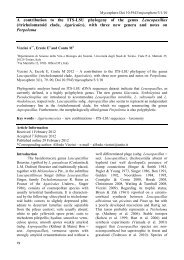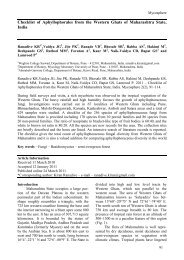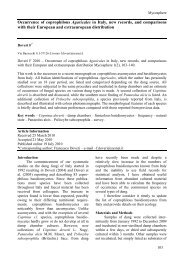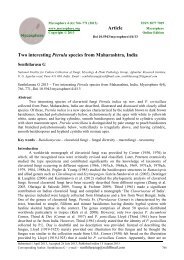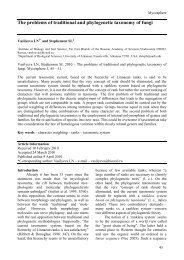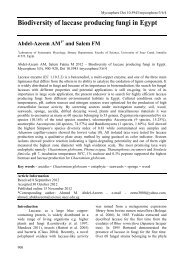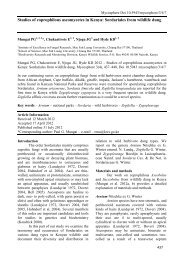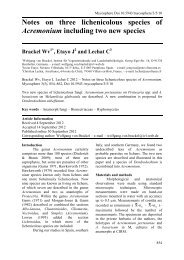View PDF - Mycosphere-online journal
View PDF - Mycosphere-online journal
View PDF - Mycosphere-online journal
You also want an ePaper? Increase the reach of your titles
YUMPU automatically turns print PDFs into web optimized ePapers that Google loves.
<strong>Mycosphere</strong> Doi 10.5943/mycosphere/3/6/12<br />
Studies of coprophilous ascomycetes in Kenya.<br />
Podospora species from wildlife dung<br />
Mungai PG 1, 2, 3 *, Njogu, JG 3 , Chukeatirote E 1, 2 1, 2<br />
and Hyde KD<br />
1 Institute of Excellence in Fungal Research, School of Science, Mae Fah Luang University, Chiang Rai 57100, Thailand<br />
2 School of Science, Mae Fah Luang University, Chiang Rai 57100, Thailand<br />
3 Biodiversity Research and Monitoring Division, Kenya Wildlife Service, P.O. Box 40241 00100 Nairobi, Kenya<br />
Mungai PG, Chukeatirote E, Njogu JG, Hyde KD 2012 – Studies of coprophilous ascomycetes in<br />
Kenya. Podospora species from wildlife dung. <strong>Mycosphere</strong> 3(6), 978–995, Doi 10.5943<br />
/mycosphere/3/6/12<br />
Moist chamber cultures were made from wildlife dung obtained from national parks in Kenya. Ten<br />
dung types produced 28 specimens of Podospora. Five species, Podospora anserina, P.<br />
argentinensis, P. australis, P. communis and P. minor are described using their morphological<br />
features. Podospora minor seems to be a rare species and is recorded for the first time in Kenya.<br />
Podospora communis, P. anserina and P. australis are the most common species on dung types<br />
examined.<br />
Key words – Arnium – biodiversity – conservation – perithecioid – Schizothecium – taxonomy<br />
Article Information<br />
Received 14 November 2012<br />
Accepted 26 November 2012<br />
Published 29 December 2012<br />
*Coresponding Author: Paul G. Mungai – email – emu@kws.go.ke<br />
Introduction<br />
A survey of coprophilous fungi in<br />
Kenya that we started three years ago has so far<br />
produced four publications (Mungai et al.<br />
2012a, 2012b, 2012c, 2012d) on some<br />
interesting ascomycetes groups. We have<br />
examined Ascobolus Pers., Saccobolus Boud.,<br />
Schizothecium Corda., and an assortment of<br />
less common Sordariales, followed now by this<br />
work on Podospora Ces., one of the<br />
commonest genera on dung (Lundqvist 1972,<br />
Doveri 2004a, 2008, Bell 2005). Podospora is<br />
predominantly coprophilous, cosmopolitan and<br />
normally perithecioid. This genus is strikingly<br />
similar to Schizothecium Corda, Arnium<br />
Nitschke ex G. Winter, Zygopleurage Boedijn<br />
and Cercophora Fuckel. It has been treated in<br />
great detail by Cain (1934), Mirza & Cain<br />
(1969), Lundqvist (1972), Bell & Mahoney<br />
(1995, 1997) Bell (2005) and Doveri (2004a,<br />
2008).Objectives of this survey are to: i) study<br />
the taxonomy of Podospora from Kenyan<br />
wildlife dung, ii) document the ecology and<br />
biodiversity of Podospora species on different<br />
wildlife dung types and, iii) create awareness<br />
on the importance of dung fungi in biodiversity<br />
conservation and management.<br />
Materials and methods<br />
Twenty-one samples from ten dung<br />
types, African elephant (Loxodonta africana<br />
Blum.), black rhinoceros (Diceros bicornis<br />
Linn.), Cape buffalo (Syncerus caffer<br />
Sparrman), zebra (Equus burchelli Gray),<br />
dikdik (Madoqua kirkii Günther), giant forest<br />
hog (Hylochoerus meinertzhageni Thomas),<br />
978
giraffe (Giraffa camelopardalis Linn.),<br />
hippopotamus (Hippopotamus amphibious<br />
Linn.), impala (Aepyceros melampus Licht.)<br />
and waterbuck (Kobus ellipsiprymnus Ogilbyi)<br />
collected from Aberdares Country Club Game<br />
Sanctuary, Tsavo East, Aberdares and Nairobi<br />
National Parks were cultured in moist chamber.<br />
Mungai et al. (2011, 2012a, 2012b) provide<br />
details of materials and methods.<br />
Isolation of coprophilous fungi was<br />
carried out as previously described by Mungai<br />
et al. (2011, 2012a, 2012b). Podospora species<br />
identification was then performed using a<br />
taxonomic key of Mirza & Cain (1969),<br />
Lundqvist (1972), Doveri (2004a) and Doveri<br />
(2008)<br />
Taxonomy<br />
Podospora Ces.<br />
Podospora in the subfamily<br />
Podosporoideae N. Lundq. (Lasiosphaeriaceae<br />
Nannf., Sordariales Chadefaud ex D.<br />
Hawksworth and O.E. Eriksson) is<br />
characterised by perithecioid, non-stromatic,<br />
more or less membranaceous, dark, superficial<br />
to semi-immersed ascomata, clavate to saccate,<br />
4- to poly-spored asci, and ascospores 2-celled<br />
at maturity with a dark pigmented upper cell, a<br />
hyaline lower pedicel and gelatinous<br />
equipment usually as caudae. It is closely<br />
related to Schizothecium Corda, Arnium<br />
Nitschke ex G. Winter, Zygopleurage Boedijn<br />
and Cercophora Fuckel. Schizothecium is<br />
mainly differentiated from Podospora by<br />
having perithecia with swollen agglutinated<br />
hairs, particularly gathered at the neck base<br />
(Lundqvist 1972, Doveri 2008).<br />
Unlike Podospora, the immature<br />
ascospores of Arnium are ellipsoidal or<br />
fusiform, while the mature ones are nonpedicellate<br />
(Lundqvist 1972, Doveri 2004a,<br />
Bell 2005). Zygopleurage differs from<br />
Podospora by having ascospores with two<br />
opposite dark cells connected by a long<br />
cylindrical intercalary cell. Cercophora has<br />
hyaline vermiform-sigmoid or cylindricgeniculate<br />
ascospores and usually cylindricclaviform<br />
asci with a thickened apical ring and<br />
often with sub-apical globules (Lundqvist 1969,<br />
1972, Abdullah & Rattan 1978, Doveri 2008).<br />
<strong>Mycosphere</strong> Doi 10.5943/mycosphere/3/6/12<br />
Podospora, a cosmopolitan and usually<br />
coprophilous genus, was treated in detail by<br />
Cain (1934), Mirza & Cain (1969), Lundqvist<br />
(1972), Bell & Mahoney (1995, 1997), Bell<br />
(2005) and Doveri (2004a, 2008). The<br />
morphological characters of peridial hairs,<br />
peridium, asci and ascospores have been<br />
extensively used in generic delimitation (Cain<br />
1934, Mirza & Cain 1969, Lundqvist 1972,<br />
Bell & Mahoney 1995, 1997, Doveri 2004a,<br />
2008, Chang & Wang 2005). Significant<br />
importance to circumscribe species of<br />
Podospora has been attributed to the shape and<br />
size of the perithecium and peridial wall cells,<br />
the number of ascospores per ascus and the<br />
shape of ascospore primary and secondary<br />
appendages (Cain 1934, Mirza & Cain 1969,<br />
Lundqvist 1972, Doveri 2004a, 2008, Bell<br />
2005, Chang & Wang 2005). The presence or<br />
absence of hairs or bristles on the perithecia,<br />
such as those found on P. anserina, P. australis<br />
and P. minor, is another useful tool in species<br />
delimitation (Mirza & Cain 1969, Lundqvist<br />
1972, Doveri 2004a, 2008, Bell 2005). Cultural<br />
attributes, though not extensively studied, seem<br />
to be important in identifying Podospora spp.<br />
or groups of related taxa.<br />
In this study, we have used<br />
morphological characters to identify the<br />
Podospora species isolated from wildlife dung<br />
in Kenya.<br />
Podospora anserina (Ces. ex Rabenh.) Niessel,<br />
Hedwigia 22:156, 1883. (Fig. 1A–K)<br />
꞊ Sphaeria anserina Ces., in litt.<br />
≡ Malinvernia anserina Ces. ex Rabenh.,<br />
Hedwigia 1: 116, 1856.<br />
꞊ Sphaeria pauciseta Ces. in Rabenh, Kl.<br />
Herb. Viv. Myc., ed. 1: 116, 1856.<br />
꞊ Sordaria pauciseta (Ces.) Ces. & De Not.,<br />
Comm. Soc. Critt. Ital. 1: 226, 1863.<br />
꞊ Malinvernia pauciseta (Ces.) Fuckel,<br />
Fungi Rhen. 1002, 1864.<br />
꞊ Malinvernia breviseta Fuckel, Jahrb.<br />
Nass. Ver. Naturk. 24: 243, 1870.<br />
꞊ Sordaria anserina (Ces.ex Rabenh.) G.<br />
Winter, Bot. Zeit. 31: 483, 1873.<br />
꞊ Sphaeria breviseta (Fuckel) W. Philips &<br />
Plowr., Grevillea 2: 187, 1874.<br />
꞊ Sordaria anserina f. ovina Sacc., Mycoth.<br />
Ven. 1179, 1878.<br />
979
<strong>Mycosphere</strong> Doi 10.5943/mycosphere/3/6/12<br />
Fig. 1 – Podospora anserina (KWSANP004-2009). A. Ascomata on dung, note tufts of pointed<br />
hairs (arrows). B Whole ascoma water mount, note hairs (arrows). C–D, G–H Mature ascospores<br />
showing pedicels and caudae (arrows). E Asci and ascospores showing uniseriate spore<br />
arrangement. F Squashed ascoma. I Paraphyses, note septation (arrow). J Ascus showing stipe<br />
(arrow). K Details of exoperidium. Scale bars: A–B = 200 µm, C–D = 20 µm, E = 50 µm, F = 500<br />
µm, G = 50 µm, H–K = 20 µm.<br />
978
꞊ Hypocopra erecta Speg., Anal. Soc.<br />
Cient. Argent. 10: 15, 1880.<br />
꞊ Sordaria erecta (Speg.) Sacc. Syll. Fung.<br />
1: 239, 1882.<br />
꞊ Podospora erecta (Speg.) Niessl,<br />
Hedwigia 22: 156, 1883.<br />
꞊ Sordaria pencillata Ellis & Everh.,<br />
Journ. Mycol. 4: 78, 1888.<br />
꞊ Podospora pencillata (Ellis & Everh.)<br />
Ellis & Everh., North Amer. Pyren.: 131, 1892.<br />
꞊ Pleurage anserina (Ces. ex Rabenh.)<br />
Kuntze, Rev. Gen. Plant. 3(3): 504, 1898.<br />
꞊ Pleurage erecta (Speg.) Kuntze, Rev.<br />
Gen. Plant. 3(3): 505, 1898.<br />
꞊ Pleurage pencillata (Ellis & Everh.)<br />
Kuntze, Rev. Gen. Plant. 3 (3):505, 1898.<br />
꞊ Sordaria communis (Speg.) Sacc. va.<br />
tetraspora Speg., Annal. Mus. Nac. Buenos<br />
Aires 6: 253, 1899.<br />
꞊ Podospora pauciseta (Ces.) Traverso,<br />
Fl. Ital. Crypt. 1, Fungi 1:431, 1907.<br />
≡ Bombardia anserina (Ces. ex Rabenh.)<br />
Mig., Thomes Krypt. Fl. 10 (1): 123, 1912.<br />
≡ Schizothecium anserinum (Ces. ex<br />
Rabenh.) E.A. Bessey, Morph. Tax. Fungi:264,<br />
1950.<br />
꞊ Podospora filiformis Cailleux, Cah.<br />
Maboke 7:102, 1969.<br />
(Adopted from Doveri 2008)<br />
Ascomata perithecioid, semi-immersed<br />
to nearly superficial, 380–600 µm high, 300–<br />
500 µm diam., scattered or in small groups,<br />
covered with few black tubercles and numerous<br />
hyphoid hairs, conical or pyriform; neck<br />
subcylindric, 90–120 µm × 70–80 µm, blackish,<br />
coriaceous, with few tufts of agglutinated, rigid,<br />
straight, brown, pointed hairs, 100–300 µm<br />
long, continuous or sparingly septate. Peridium<br />
pseudoparenchymatous: endostratum of pale<br />
translucent thin-walled polygonal cells 10–25<br />
µm wide; exostratum of thick-walled polygonal<br />
cells where hyaline wavy septate hairs<br />
originate, 2–4 µm wide. Paraphyses cylindricmoniliform,<br />
exceeding the asci, 4.5–6.5 µm<br />
broad, septate, with hyaline vacuoles. Asci 4spored,<br />
175–275 × 22–29 µm, clavate, with a<br />
thin apical ring, long and slender, lobate stipe.<br />
Ascospores obliquely uniseriate, two-celled at<br />
maturity: spore head 32–36 × 17–20 µm,<br />
immature spoon shaped, mature ellipsoidal,<br />
somewhat unequilateral, smooth, dark brown,<br />
<strong>Mycosphere</strong> Doi 10.5943/mycosphere/3/6/12<br />
with a centric germ pore; lower cell<br />
(pedicel) cylindrical, 20–30 × 4–5 µm, slightly<br />
pointed; upper cauda, sub-apical, fairly long,<br />
lash-like, furrowed, tip curved, 30–80 × 6.5–8<br />
µm at base; lower cauda solid, filiform;<br />
additional two to three, short, filiform caudae,<br />
with hooked tips, attached to basal part of<br />
primary appendage near septum.<br />
Material examined – 7 isolates from<br />
dung incubated for between 6 and 20 days –<br />
KENYA, Aberdare Country Club Game<br />
Sanctuary, Central Province, bushed grassland,<br />
GPS S00 ° 19 28.1 E036 ° 55’54.3”, altitude 2161<br />
m, giraffe, 29 August 2009, P. Mungai,<br />
KWSACC003-2009; Aberdare National Park,<br />
Central Province, montane forest, GPS,<br />
S00°21’42.0” E036°52’55.9”, altitude 2076m,<br />
black rhinoceros, 29 August 2009,<br />
KWSANP004-2009; Nairobi National Park,<br />
Nairobi Province, bushed grassland, GPS<br />
S01°20’50.1” E036°47’51.3”, altitude 1695 m,<br />
hippopotamus, 31 August 2009, P. Mungai,<br />
KWSNNP012-2009; Nairobi National Park,<br />
Nairobi Province, bushed grassland, GPS<br />
0252737 9847748, altitude 1876 m, Cape<br />
buffalo, 27 August 2009, P. Mungai,<br />
KWSNNP004-2009; Tsavo East National Park,<br />
Coast Province, riverine habitat, GPS<br />
S03°21’064” E038°37’501”, altitude 514 m,<br />
Cape buffalo, 23 September 2008, P. Mungai,<br />
KWSTE007A-2008; Tsavo East National Park,<br />
Coast Province, riverine, GPS S03°02’29.7”,<br />
E038°41’35.8”, altitude 354 m, dikdik, 27<br />
August 2009, P. Mungai, KWSTE005B-2009;<br />
Tsavo East National Park, Coast Province,<br />
riverine, GPS S03°21’666”, E038°38’772”,<br />
altitude 514 m, African elephant, 23 August<br />
2009, P. Mungai, KWSTE005A-2009.<br />
Notes – Pododpora anserina sect.<br />
Malinvernia Rabenh. is distinguished from P.<br />
australis (Speg.) Niessl sect. Andreanszkya<br />
Tóth. by the former’s smaller non-apiculate<br />
ascospores with more complex furrowed<br />
caudae and the latter’s notably simpler taenioid<br />
caudae (Lundqvist 1972, Doveri 2004a, 2008,<br />
Bell 2005). The morphology of these<br />
collections agree with that observed for this<br />
taxon in previous examinations (Cain 1934,<br />
Lundqvist 1972, Bell 1983, 2005, Doveri<br />
2004a, 2008). This is a common species on<br />
wildlife dung in Kenya.<br />
978
<strong>Mycosphere</strong> Doi 10.5943/mycosphere/3/6/12<br />
Fig. 2 – Podospora argentinensis (KWSACC002-2009). A Ascoma squash. B Free mature<br />
ascospores. C Details of exoperidium. D Paraphyses. E–F Free mature ascospores showing pedicel<br />
and caudae. Scale bars: A = 200 µm, B = 50 µm, C–F = 20 µm.<br />
978
Podospora argentinensis (Speg.) J.H. Mirza &<br />
Cain, Can. J. Bot. 47: 2008, 1969. (Fig. 2A–F)<br />
≡ Sordaria argentinensis Speg., Anal.<br />
Mus. Nac. Buenos Aires 23:49, 1912.<br />
≡ Pleurage argentinensis (Speg.), C.<br />
Moreau, Encycl. Mycol. 25: 252, 1953.<br />
Ascomata perithecioid, immersed or<br />
semi-immersed, 400–670 µm high, 200–500<br />
µm diam., scattered, upper portion of perithecia<br />
with black tubercles, globose to pyriform.<br />
Peridium membranaceous; endoperidium of<br />
thin-walled polygonal cells; exoperidium<br />
composed of brownish thin translucent textura<br />
globulosa-angularis, cells measuring 6–11 ×<br />
5–7 µm. Neck short cylindrical, fully covered<br />
with black papillae. Paraphyses numerous,<br />
filiform above, ventricose below, fugacious.<br />
Asci 8-spored, 180–200 × 30–40 µm, clavate,<br />
narrowly rounded at apices, long stipitate.<br />
Ascospores biseriate, two-celled: spore head<br />
27.5–35 × 15–19 µm, ovoid-ellipsoidal,<br />
smooth, brown to blackish, thin-walled, with<br />
an eccentric germ pore; pedicel often appearing<br />
twisted, flattened, cylindrical, or slightly<br />
clavate 18–23 µm long, 6.5–9 µm broad at base;<br />
upper caudae formed as a lyre-shaped structure,<br />
sometimes elongated; lower caudae, fugacious,<br />
small, formed as a whorl at the proximal end of<br />
the pedicel.<br />
Material examined – 2 isolates from<br />
dung incubated 34 and 43 days – KENYA,<br />
Nairobi National Park, Nairobi Province, GPS<br />
37M0257082, 9850692, altitude 1668 m, zebra,<br />
20 August 2010, P. Mungai, KWSNNP016-<br />
2010; Aberdare Country Club Game Sanctuary<br />
in Central Province, S00°19’28.1”<br />
E036°55’54.3”, altitude 2161 m, zebra, bushed<br />
grassland, 30 August 2009, P. Mungai,<br />
KWSACC002-2009.<br />
Notes – Podospora argentinensis sect.<br />
Rhypophila Lundq. is closely related to P.<br />
decipiens (G. Winter ex Fuckel) Niessl of the<br />
same section but the former has smaller<br />
ascospores (Mirza & Cain 1969, Doveri 2004a,<br />
Bell 2005) while the latter does not have a<br />
cauda attached at the end of the pedicel (Chang<br />
& Wang 2004). This species has been recorded<br />
many times from tropical areas and is deemed<br />
to be this region’s substitute of P. decipiens<br />
(Mirza & Cain 1969, Lundqvist 1973, Krug &<br />
Khan 1989, Richardson 2001), which is<br />
common in temperate areas. The characters of<br />
<strong>Mycosphere</strong> Doi 10.5943/mycosphere/3/6/12<br />
the Kenyan collection are similar to the<br />
descriptions made in previous studies (Mirza &<br />
Cain 1969, Bell 2005).<br />
Podospora australis (Speg.) Niessl, Hedwigia<br />
22: 156, 1883. (Figs. 3A–G, 4A–G)<br />
≡ Hypocopra australis Speg. Anal. Soc.<br />
Cient. Argent. 10: 137, 1880.<br />
≡ Sordaria australis (Speg.) Sacc., Syll.<br />
Fung. 1:239, 1882.<br />
≡ Pleurage australis (Speg.) Kuntze, Rev.<br />
Gen. Plant. 3(3): 505, 1898.<br />
꞊ Sordaria apiculifera Speg. Anal. Mus.<br />
Nac. Buenos Aires 6: 251, 1899.<br />
꞊ Pleurage taenioides Griffiths, Mem.<br />
Torrey Bot. Club 11: 58, 1901.<br />
꞊ Sordaria taenioides (Griffiths) Sacc., Syll.<br />
Fung. 17: 602, 1905.<br />
꞊ Sordaria macrura A. Bayer, Acta Soc.<br />
Nat. Moraviae 1: 95, 1924.<br />
꞊ Pleurage apiculifera (Speg.) C. Moreau,<br />
Encycl. Mycol. 25: 252, 1953.<br />
꞊ Podospora taenioides (Griffiths) Cain,<br />
Can. J. Bot. 40: 460, 1962.<br />
꞊ Podospora apiculifera (Speg.) Mirza &<br />
Cain, Can. J. Bot. 47: 2006, 1969.<br />
(Adopted from Doveri 2004a)<br />
Ascomata perithecioid semi-immersed<br />
to superficial, 550–850 µm high to 500–620<br />
µm diam., scattered, olive-brown to nearly<br />
black, pyriform; the exposed portion covered<br />
with long, septate, branched, olivaceous brown<br />
and hyaline tipped hairs 2.5–3 µm broad.<br />
Peridium semi-membranaceous, translucent to<br />
slightly opaque; endoperidium of textura<br />
angularis cells; exoperidium of thick-walled<br />
textura angularis cells 8–11 × 6.5–8.5 µm.<br />
Neck 180–240 × 180–190 µm, black, opaque,<br />
papilliform to cylindrical; with, septate, rigid<br />
hairs 27.5–38.5 µm long, 2–4 µm broad at base.<br />
Paraphyses cylindric-moniliform or filiform,<br />
longer than asci, 5–6 µm broad, septate, rarely<br />
branched. Asci 4-spored, 258–307 × 36.5–44<br />
µm, unitunicate, narrowly cylindrical, tapering<br />
below into a slender very long stipe, with an<br />
indistinct apical apparatus, apex narrow.<br />
Ascospores obliquely uniseriate at maturity,<br />
two-celled: spore head 50.5–55.5 × 25–27 µm,<br />
narrowly ovoid to ellipsoidal, symmetrical,<br />
dark brown, smooth, thick walled, flattened at<br />
base with an apical conspicuous germ pore;<br />
lower cell (pedicel) reduced to a conspicuous<br />
978
<strong>Mycosphere</strong> Doi 10.5943/mycosphere/3/6/12<br />
978
<strong>Mycosphere</strong> Doi 10.5943/mycosphere/3/6/12<br />
Fig. 3 – Podospora australis (KWSACC002-2009). A Necks of semi-immersed ascomata on dung.<br />
B Ascoma squash. C Perithecial neck. D Septate and hyaline perithecial hairs. E Details of<br />
exoperidium. F Mature and immature asci. G Free mature ascospore showing taenioid caudae<br />
(black arrow) and apiculum (blue arrow). Scale bars: A = 1000 µm, B–C = 200 µm, D–E, G = 20<br />
µm, F = 50 µm.<br />
979
<strong>Mycosphere</strong> Doi 10.5943/mycosphere/3/6/12<br />
Fig. 4 – Podosdpora australis (KWSACC002-2009). A–B Free mature ascospores, note gelatinous<br />
equipment (arrows). C Mature ascospore among paraphyses, note apiculum (arrow). D Details of<br />
paraphyses. E–G Details of mature ascospores, note caudae with transverse banding (arrows). Scale<br />
bars: A–B = 50 µm, C–G = 20 µm.<br />
980
small basal triangular apiculum, hyaline, 4–6.5<br />
× 2–3 µm; upper cauda 50–100 µm long, 8–15<br />
µm broad at the base, more segmented<br />
(taenioid) in proximal part, longitudinally<br />
furrowed and poly-channeled, wavy, attached<br />
slightly eccentrically, not covering the germ<br />
pore; lower cauda similar, long, originating<br />
from the basal end of spore, completely<br />
covering the apiculum, hollow and taenioid.<br />
Material examined – 4 isolates from<br />
dung incubated between 12 and 21 days –<br />
KENYA, Aberdare Country Club Game<br />
Sanctuary, Central Province, GPS S00 ° 19’28.1”<br />
E036 ° 55’54.3”, altitude 2161 m, zebra, 30<br />
August 2009, P. Mungai, KWSACC002-2009;<br />
Nairobi National Park, Nairobi Province, GPS<br />
37M0257532, 9848948, altitude 1647 m,<br />
giraffe, 20 August 2010, P. Mungai,<br />
KWSNNP017A-2010; Nairobi National Park,<br />
Nairobi Province, GPS 37M0257532, 9848948,<br />
altitude 1647 m, giraffe, 20 August 2010, P.<br />
Mungai, KWSNNP017B-2010; Nairobi<br />
National Park, Nairobi Province, GPS<br />
37M0255297, 9848528, altitude 1693 m, zebra,<br />
20 August 2010, P. Mungai, KWSNNP016-<br />
2010.<br />
Notes – Podospora australis sect.<br />
Andreanszkya (Tóth) Lundq., noted for having<br />
a reduced pedicel, is quite unique and is<br />
identified by its large ascospores with a small,<br />
basal apiculum and taenioid caudae, one on<br />
each side of the spore head (Mirza & Cain<br />
1969, Lundqvist 1972, Doveri 2004a, 2008,<br />
Bell 2005). It is differentiated from the related<br />
P. anserina by its larger apiculate ascopores<br />
and longitudinally poly-channeled and<br />
transversely banded caudae (Lundqvist 1972,<br />
Doveri 2004a, Bell 2005). Lundqvist (1972)<br />
argues that P. apiculifera (Speg) Mirza and<br />
Cain is a depauperate form of Podospora<br />
australis. Previous records for this taxon in<br />
Kenya are from the dung of steenbok, impala,<br />
bushbuck, hippopotamus, buffalo, zebra, eland<br />
zebra, giraffe and cattle (Caretta et al. 1998,<br />
Krug & Khan 1989). It seems to be a very<br />
common species on wildlife dung.<br />
Podospora communis (Speg.) Niessl,<br />
Hedwigia 22: 156, 1883. (Figs. 5A–E, 6A–E)<br />
≡ Hypocopra communis Speg., Anal. Soc.<br />
Cie. Argent. 10: 14, 1880.<br />
≡ Sordaria communis (Speg.) Sacc. Syll.<br />
<strong>Mycosphere</strong> Doi 10.5943/mycosphere/3/6/12<br />
Fung. 1: 231, 1882.<br />
꞊ Sordaria vestita Zopf, Zeits. Naturw. 56:<br />
556, 1883.<br />
꞊ Podospora vestita (Zopf) G. Winter,<br />
Rabenh. Krypt. Fl. 1 (2): 176, 1885.<br />
꞊ Sordaria macrostoma Speg., Anal. Mus.<br />
Nac. Buenso Aires 6: 252, 1899.<br />
꞊ Pleurage vestita (Zopf) Griffiths, Mem.<br />
Torrey Bot. Club 11: 76, 1901.<br />
꞊ Bombardia vestita (Zopf). Mig.,<br />
Thome’s Krypt. Fl. 10 (1): 126, 1913.<br />
꞊ Sordaria occidentalis Bat. & Pontual,<br />
Bol. Agric. Pernambuco 15: 38, 1948.<br />
꞊ Pleurage macrostoma (Speg.) C.<br />
Moreau, Encyl. Mycol. 25: 262, 1953.<br />
(Adopted from Doveri 2004a)<br />
Ascomata perithecioid, superficial,<br />
670–1100 × 410–530 μm, scattered or<br />
gregarious in small groups, semi-transparent,<br />
becoming olivaceous or dark brown, adorned<br />
with fine brown hairs of over 40 μm long,<br />
disappearing with age, obpyriform. Neck<br />
conical or cylindrical, 150–385 × 130–150 μm,<br />
roughened with small, black papillae or<br />
glabrous, opaque, usually curved; ostiole over<br />
80 μm diam. Peridium membranaceous, semitransparent;<br />
endoperidium of textura angularis<br />
cells; exoperidium consisting of yellowisholive<br />
textura angularis cells. Paraphyses<br />
reduced to a mass of elongated vesicles. Asci 8spored,<br />
240–265 × 40–50 μm, unitunicate,<br />
clavate, with a narrow tapering broad apex,<br />
fairly long stipe, apical ring thin and barely<br />
visible. Ascospores biseriate, two-celled: spore<br />
head 29–40 × 16–25 µm, at first sub-cylindric,<br />
later ellipsoidal with truncate base,<br />
occasionally asymmetrical, dark to olivaceous<br />
brown, opaque, thick walled, with a minute<br />
apical germ pore; pedicel 25–42 × 5–6 μm,<br />
cylindrical, wider at the base, hyaline, slightly<br />
curved in the early stages, straight later; upper<br />
caudae four, flattened, short, independent,<br />
curved, composed of two filaments, lash-like,<br />
larger, 40–50 × 2–4 μm diam, sub-apical,<br />
surrounding the germ pore; lower caudae four,<br />
3.5–5 × 1.5–2.5 μm, curved, each<br />
independently arising from apex of the pedicel,<br />
lash-like, 3.5–5 × 1.5–2.5 μm.<br />
Material examined – 14 isolates from<br />
dung incubated between 12 and 64 days –<br />
KENYA, Nairobi National Park, Nairobi<br />
Province, UTM37 02537515 M 9849130,<br />
978
<strong>Mycosphere</strong> Doi 10.5943/mycosphere/3/6/12<br />
Fig. 5 – Podospora communis (KWSNNP001-2009). A Ascoma squash. B Asci with ascospores<br />
in different stages of maturity. C Pointed ascus tip. D Free mature ascospore showing 4 apical<br />
(white arrow) and 4 basal caudae (black arrow). E Free mature ascospore showing 4 basal<br />
caudae (arrow). Scale bars: A = 200 μm, B, E = 50 μm, C–D = 20 μm.<br />
979
<strong>Mycosphere</strong> Doi 10.5943/mycosphere/3/6/12<br />
Fig. 6 – Podospora communis (KWSNNP001-2009). A Centrum contents from squashed ascoma.<br />
B Immature ascospores. C Mature ascospore. D Ascospores at various stages of maturity. E Details<br />
of exoperidium. Scale bars: A, E = 200 µm, B = 20 µm, C–D = 50 µm.<br />
980
altitude 1877 m, Cape buffalo, 18 August 2009,<br />
P. Mungai, KWSNNP001-2009; Nairobi<br />
National Park, UTM37 0252737 M 9847748,<br />
altitude 1879 m, impala, 18 August 2009, P.<br />
Mungai, KWSNNP003-2009; UTM37<br />
0252737 M 9847748, altitude 1878 m, black<br />
rhinoceros, 18 August 2009, P. Mungai,<br />
KWSNNP004-2009; GPS UTM37 0253662<br />
M9847748, altitude 1877m, giraffe, 18 August<br />
2009, P. Mungai KWSNNP005-2009; UTM37<br />
0254976 M 9850544, altitude 1877 m,<br />
hippopotamus, 18 August 2009, P. Mungai,<br />
KWSNNP006-2009; GPS 37M0255191<br />
9849808, altitude 1693 m, bushed grassland,<br />
Cape buffalo, 20 August 2010, P. Mungai,<br />
KWSNNP015-2010; Aberdare Country Club<br />
Game Sanctuary, Central Province, GPS<br />
S00 ° 19 28.1 E036 ° 55 54.3, altitude 2061 m,<br />
impala, 30 August 2009, P. Mungai,<br />
KWSACC001-2009; GPS S00 ° 19’28.1”,<br />
E036 ° 55 54.3”, altitude 2161 m, bushed<br />
grassland, zebra, 30 August, 2009, P. Mungai,<br />
KWSACC002-2009; GPS S00 ° 19 28.1<br />
E036 ° 55’54.3”, altitude 2161 m, bushed<br />
grassland, giraffe, 30 August 2009. P. Mungai,<br />
KWSACC003-2009; Aberdare Nairobi<br />
National Park, Central Province, GPS<br />
S00 ° 19’28.1” E036 ° 55’54.3”, altitude 2061 m,<br />
black rhinoceros, 29 August 2009, P. Mungai,<br />
KWSANP004-2009; GPS S00 ° 21’26.4”<br />
E036 ° 51’23.8”, altitude 2004 m, montane<br />
forest, giant forest hog, 29 August 2009, P.<br />
Mungai, KWSANP001-2009; GPS<br />
S00 ° 20’23.2” E036 ° 47’11.1”, altitude 2075 m,<br />
montane forest, waterbuck, 29 August 2009, P.<br />
Mungai, KWSANP005-2009; Tsavo East<br />
National Park, Coast Province, GPS<br />
S03 ° 02’29.7” E038 ° 41’35.8”, altitude 354 m,<br />
27 August 2009, P. Mungai, KWSTE004-2009;<br />
GPS S03 ° 02’24.9” E038 ° 42’57.1”, altitude 343<br />
m, waterbuck, 27 August 2009, P. Mungai<br />
KWSTE006-2009; GPS S03 ° 21’666”<br />
E038 ° 38’772”, altitude 514 m, riverine, African<br />
elephant, 23 September 2008, P. Mungai,<br />
KWSTE007-2008.<br />
Notes – The Kenyan collections have<br />
typical features for the species and compare<br />
well with descriptions of same species in<br />
previous examinations (Lundqvist 1972,<br />
Doveri 2004, Bell 2005). Podospora communis<br />
belongs to the sect. Malinvernia noted for<br />
having clavate or dumb-bell shaped immature<br />
<strong>Mycosphere</strong> Doi 10.5943/mycosphere/3/6/12<br />
ascospores with complex gelatinous equipment<br />
at maturity, and peridium lacking a middle<br />
gelatinous layer. The main diagnostic<br />
characters for P. communis include its long,<br />
cylindrical pedicel equipped with four short,<br />
claw-like, independent gelatinous caudae on<br />
the lower end and the presence of four similar<br />
caudae on the apex of the spore head (dark cell)<br />
(Lundqvist 1972). However, our Kenyan<br />
collections have some slight variance with the<br />
Australian collection which had three basal<br />
caudae (Bell 2005). P. spinulosa R.S. Khan &<br />
Cain, in the same section, is differentiated from<br />
P. communis by having short spinules on<br />
perithecial neck and more caudae at the base of<br />
the pedicel; P. hyalopilosa (R. Stratton) Cain<br />
has hyaline perithecial neck hairs and a pedicel<br />
with only a single apical cauda; P.<br />
multicaudiculata Cailleux has a slightly hairy<br />
neck, shorter asci and multiple but simpler<br />
structured caudae; P. austrohemisphaerica N.<br />
Lundq. has rigid neck hairs, larger spores,<br />
multiple caudae, usually four at each pole,<br />
additonal shorter caudae at base of pedicel and<br />
a sheath covering the pedicel and spore head;<br />
the neck of P. deropodalis R.S. Khan & Cain is<br />
covered with short spinules, it has smaller<br />
spores but with longer pecidels and variable<br />
number of upper caudae and fewer lower<br />
caudae; P. alexandri Doveri is similar but can<br />
be differentiated by its larger ascospores and<br />
the inconspicuous caudae when mounted in<br />
water (Doveri 2004a, 2004b, 2008). Podospora<br />
communis is the most widespread and<br />
commonest species occurring on several<br />
wildlife dung types in Kenya (Table 1).<br />
Podospora minor Ellis & Everh., Amer. Nat.<br />
31: 341, 1897. (Figs. 7A–F, 8A–D, 9A–H)<br />
≡ Sordaria minor (Ellis & Everh) Sacc. & P.<br />
Syd., Syll. Fung. 14: 493, 1899.<br />
≡ Pleurage minor (Ellis & Everh) Griffiths,<br />
Mem. Torrey Bot. Club 11: 67, 1901.<br />
Ascomata perithecioid, superficial,<br />
450–810 µm high., 165–470 µm diam.,<br />
scattered, black, opaque, coriaceous, with short<br />
rigid septate, brown and hyaline tipped hairs<br />
23.5–53 × 3–4 µm, conical to pyriform. Neck<br />
black, cylindrical, 150–200 × 200–225 µm,<br />
adorned with stiff septate hyaline tipped hairs.<br />
Peridium coriaceous, pseudo-bombardioid, 4layered;<br />
outermost peridial wall layer<br />
978
<strong>Mycosphere</strong> Doi 10.5943/mycosphere/3/6/12<br />
Fig. 7 – Podospora minor (KWSACC002-2009). A Ascoma on dung. B Squashed ascoma mount,<br />
note hairs (arrow). C Mature and immature asci and ascospores, note apex (white arrow) and<br />
gelatinous equipment (black arrow). D–E Free mature and immature ascospores, note caudae with<br />
circinate ends (arrows). F Ascus, showing spore arrangement and stipe (arrow). Scale bars: A =<br />
500 µm, B = 200 µm, C–F = 50 µm.<br />
979
<strong>Mycosphere</strong> Doi 10.5943/mycosphere/3/6/12<br />
Fig. 8 – Podospora minor (KWSACC002-2009). A Paraphyses. B Details of peridium. C Details of<br />
ascomatal hairs. D Details of caudae. Scale bars: A–D = 20 µm.<br />
978
Table 1 Occurrence and distribution of Podospora spp. in study area<br />
<strong>Mycosphere</strong> Doi 10.5943/mycosphere/3/6/12<br />
Fungi name Herb. No. Dung type Habitat GPS/Altitude<br />
(m asl)<br />
Date<br />
KWSTE005A-2009 African elephant riverine S03<br />
Podospora anserina<br />
° 21 666 E038 ° 38.772 514<br />
Podospora anserina KWSANP004-2009 black rhinoceros montane forest S00 ° 21 42 0 E036 ° 52 55 .9 2076<br />
Podospora anserina<br />
Podospora anserina<br />
KWSNNP004-2009<br />
KWSTE007A-2008<br />
Cape buffalo<br />
zebra<br />
bushed grassland<br />
riverine habitat<br />
0252737<br />
S03<br />
9847748 1876<br />
° 21 064 E038 ° Podospora anserina KWSTE005B-2009 dikdik riverine S03<br />
37 501 514<br />
° 02 297 E038 ° Podospora anserina KWSACC003-2009 giraffe bushed grassland S00<br />
41 358 354<br />
° 19 28 1 E036 ° Podospora anserina KWSNNP012-2009 hippopotamus bushed grassland S01<br />
5554 3 2161<br />
° 20 50 1 E036 ° Podospora argentinensis<br />
Podospora argentinensis<br />
KWSNNP016-2010<br />
KWSACC002-2009<br />
zebra<br />
zebra<br />
wooded grassland<br />
bushed grassland<br />
37M0257082<br />
S00<br />
47 513<br />
9850692<br />
1695<br />
1668<br />
° 19 28 1 E036 ° Podospora australis KWSACC002-2009 zebra bushed grassland S00<br />
55 54 .3 2161<br />
° 19 28 1 E036 ° Podospora australis<br />
Podospora australis<br />
KWSNNP016-2010<br />
KWSNNP017B-<br />
2010<br />
zebra<br />
giraffe<br />
wooded grassland<br />
wooded grassland<br />
37M0255297<br />
37M0257532<br />
55 54 .3<br />
9848528<br />
9848948<br />
2161<br />
1693<br />
1647<br />
Podospora australis KWSNNP017A-<br />
2010<br />
giraffe wooded grassland 37M0257532 9848948 1647<br />
Podospora communis KWSTE007-2008 African elephant riverine S03 ° 21 66 6 E038 ° 38.77 2 514<br />
Podospora communis KWSNNP004-2009 black rhinoceros bushed grassland UTM370252<br />
737<br />
M9847748 1878<br />
Podospora communis KWSANP004-2009 black rhinoceros montane forest S00 ˚ 19 28 1 E036 ˚ Podospora communis KWSNNP001-2009 Cape buffalo Grassland UTM370253<br />
7515<br />
55 54 3<br />
M9849130<br />
2061<br />
1877<br />
Podospora communis<br />
Podospora communis<br />
KWSNNP015-2010<br />
KWSACC002-2009<br />
Cape buffalo<br />
zebra<br />
bushed grassland<br />
bushed grassland<br />
37M0255191<br />
S00<br />
9849808 1693<br />
° 19 28 1 E036 ° Podospora communis KWSTE004-2009 zebra Savannah S03<br />
55 54 3 2161<br />
˚ 02 29 7 E038 ˚ Podospora communis KWSANP001-2009 giant forest hog montane forest S00<br />
4135 8 354<br />
° 21 26 4 E036 ° Podospora communis KWSACC003-2009 giraffe bushed grassland S00<br />
51 23 8 2004<br />
° 19 28 1 E036 ° 55 54 3 2161<br />
Podospora communis KWSNNP006-2009 hippopotamus Wetland UTM370254<br />
976<br />
M9850544 1877<br />
Podospora communis KWSNNP003-2009 impala Grassland UTM370252<br />
737<br />
M9847748 1879<br />
Podospora communis KWSACC001-2009 impala bushed grassland S00 ˚ 19 28 1 E036 ˚ Podospora communis KWSANP005-2009 waterbuck montane forest S00<br />
55 54 3 2061<br />
° 20 23 2 E036 ° Podospora communis KWSTE006-2009 waterbuck Riverine S03<br />
4711 1 2075<br />
˚ 02 24 9 E038 ˚ Podospora minor KWSACC002-2009 zebra bushed grassland S00<br />
42 57 1 343<br />
° 19 28 1 E036 ° 55 54 3 2161<br />
991
composed of textura angularis thick-walled<br />
brown elongated polygonal cells; second layer<br />
from outside made up of hyaline, thick-walled<br />
gelatinous polygonal cells; third layer of darker,<br />
thick-walled flattened cells; fourth layer<br />
composed of lighter thin-walled polygonal<br />
cells. Paraphyses exceeding the asci, filiform<br />
above and ventricose below, septate, 3–4.5 µm<br />
broad, hyaline. Asci 8-spored, 245–345 × 27.5–<br />
43 µm, cylindrical-clavate, unitunicate, narrow,<br />
evanescent, round apex, short stipitate.<br />
Ascospores uniseriate to biseriate, at first<br />
hyaline, single-celled, fusiform then cylindrical;<br />
spore head 37.5–47.5 × 20.5–25 µm at maturity,<br />
slightly inequilateral, black-brown, ellipsoidal<br />
to fusiform; germ pore apical; pedicel hyaline,<br />
cylindrical or clavate, broader at the tip; upper<br />
cauda longer and broader, 75.5–126.5 × 9–12<br />
µm, lash-like, appearing striated and furrowed,<br />
eccentric, not covering the germ pore, hollow;<br />
lower cauda shorter and narrower, 46–73.5 ×<br />
4.5–5 µm, hyaline, hollow, attached to distal<br />
end of the pedicel, tips circinate.<br />
Material examined – one specimen on<br />
dung incubated for 42 days – KENYA,<br />
Aberdare Country Club Game Sanctuary,<br />
Central Province, GPS S00 ° 19’28.1”<br />
E036 ° 55’54.3”, altitude 2161m, zebra, 30<br />
August 2009, P. Mungai, KWSACC002-2009.<br />
Notes – Podospora minor is in the<br />
section Podospora. The ascospores of P. minor<br />
are morphologically similar to those of P.<br />
fimiseda (Ces. & De Not.) Niessl. belonging to<br />
the same section but are slightly smaller. The<br />
characters of P. minor seem to be intermediate<br />
between P. appendiculata (Auswer.) Niessl and<br />
P. fimiseda. This Kenyan collection has broader<br />
asci and larger ascospores in comparison to the<br />
specimen examined by Mirza & Cain (1969).<br />
This species appears to be rare in wildlife dung<br />
and we make the first record of P. minor in<br />
Kenya.<br />
Ecology<br />
Podospora communis (50%), P.<br />
anserina (25%) and P. australis (14.3%) are<br />
the most common on the dung types examined.<br />
(Adopted from Zak & Willig 2004)<br />
Commonly collected (African elephant,<br />
black rhinoceros, zebra, Cape buffalo and<br />
giraffe) and rarely collected dung types (dikdik,<br />
hippopotamus, giant forest hog, impala and<br />
<strong>Mycosphere</strong> Doi 10.5943/mycosphere/3/6/12<br />
waterbuck) were found in different habitat<br />
types, incubated and examined (Table 1).<br />
Type, structure, texture, moisture<br />
contents and age of dung collected are<br />
important variables for coprophilous<br />
Podospora. The structure and composition of<br />
dung varies according to the animal species<br />
voiding it. The dung of African elephant is<br />
usually voided as one or two very coarse large<br />
randomly dispersed piles; black rhinoceros and<br />
hippopotamus dung are also large, less coarse<br />
and look very similar. However, black<br />
rhinoceros dung was always voided at one<br />
point.<br />
Hippopotamus is territorial and thus<br />
usually marks its territory by splashing dung on<br />
vegetation within the territory and therefore its<br />
dung is always a mixture of several days<br />
voided biomass. The texture of Cape buffalo<br />
dung was the finest for the large mammals<br />
sampled. The rest of the wild animals sampled<br />
void dung in form of pellets of various shapes<br />
and sizes. Zebra has the largest pellets followed<br />
by giraffe while dikdik has the smallest dung<br />
pellets sampled.<br />
Moisture content of the dung has a<br />
great influence on Podospora sporulation.<br />
Extremely wet dung samples such as those<br />
from the very rainy mountainous Aberdares<br />
National Park needs thorough air-drying after<br />
sampling. This was noted to have some<br />
influence on Podospora species occurrence.<br />
The time the dung is exposed since<br />
voiding and the time it is sampled is also a<br />
crucial variable. Very old and dry dung does<br />
not yield as many isolates as freshly voided<br />
dung.<br />
Dung sampled from grassland habitats<br />
produced the most Podospora isolates in this<br />
study (Table 1).<br />
Conclusion<br />
Coprophilous Podospora species<br />
diversity in Kenya is high and seems to be<br />
influenced by a number of factors both biotic<br />
and abiotic. The correlation observed between<br />
the structure of dung and type on one hand and<br />
Podospora on the other hand need further<br />
elucidation. This study has helped create<br />
awareness on the need to understand dung<br />
fungi and its ecological roles. It is hoped that<br />
there will be a shift in policy to embrace fauna,<br />
992
<strong>Mycosphere</strong> Doi 10.5943/mycosphere/3/6/12<br />
Fig. 9 – Podospora minor (KWSACC002-2009). A Squashed ascoma. B Ascospores showing<br />
caudae, note coiled ends (arrow). C Details of cauda, note the furrows (arrow). D Details of pedicel,<br />
note the curvature (arrow). E Immature ascospores. F Ascomatal hairs, note the hyaline tips. G–H<br />
Ascomatal wall. Scale bars: A = 200 µm, B, G = 50 µm, C–F, H = 20 µm.<br />
993
flora and fungi (3Fs) as a new paradigm fo<br />
Kenyan biodiversity conservation and<br />
management.<br />
Acknowledgements<br />
This work was funded by Kenya<br />
Wildlife Service (KWS), Mushroom Research<br />
Foundation and Novozymes A/S of Denmark.<br />
We are grateful to the Director (KWS) and<br />
Deputy Director, Biodiversity Research and<br />
Monitoring Division, for allowing us to<br />
conduct the study within the National Parks<br />
and Reserves in Kenya. We wish to appreciate<br />
and thank Dr Francesco Doveri for taking a lot<br />
of his time to do a thorough taxonomic<br />
correction of this paper. It is kindly noted that<br />
without his thoughtful advice and input this<br />
work could not have been possible. We also<br />
feel highly indebted to staff and students of the<br />
Institute of Excellence in Fungal Research,<br />
School of Science, Mae Fah Luang University,<br />
Thailand and KWS colleagues, Mr Patrick<br />
Omondi, Dr Samuel Andanje, Dr Francis<br />
Gakuya, Mr Moses Otiende and Mrs Elsie<br />
Wambui Maina for their support during this<br />
study. Ms Asenath Akinyi assisted in<br />
laboratory examination, grammar and spelling<br />
checks of the text and neatly arranging the<br />
tabulated results.<br />
References<br />
Abdullah SK, Rattan SS. 1978 – Zygopleurage,<br />
Tripterosporella and Podospora<br />
(Sordariaceae: Pyrenomycetes) in Iraq.<br />
Mycotaxon 7, 102–116.<br />
Bell A. 1983 – Dung Fungi. An Illustrated<br />
Guide to Coprophilous Fungi in New<br />
Zealand. Victoria University Press,<br />
Wellington. 88 pp.<br />
Bell A. 2005 – An illustrated guide to the<br />
coprophilous ascomycetes of Australia.<br />
CBS Biodiversity Series 3.<br />
Centraalbureau voor Schimmelcultures,<br />
Utrecht, The Netherlands. 172 pp.<br />
Bell AE, Mahoney DP. 1995 – Coprophilous<br />
fungi in New Zealand. I. Podospora<br />
species with swollen agglutinated<br />
perithecial hairs. Mycologia 87, 375–<br />
396.<br />
<strong>Mycosphere</strong> Doi 10.5943/mycosphere/3/6/12<br />
Bell AE, Mahoney DP. 1997 – Coprophilous<br />
fungi in New Zealand. II. Podospora<br />
species with coriaceous perithecia.<br />
Mycologia 89, 908–915.<br />
Cain RF. 1934 – Studies of coprophilous<br />
Sphaeriales in Ontario. University of<br />
Toronto Studies in Biology Series 38,<br />
1–126.<br />
Chang J-H Wang Y-Z. 2005 – A new species of<br />
Podospora from Taiwan. Botanical<br />
Bulletin of Academia Sinica 46, 169–<br />
173.<br />
Doveri F. 2004a – Fungi Fimicoli Italici.<br />
Associazione Micologica Bresadola,<br />
Trento, Italy.<br />
Doveri F. 2004b – Podospora alexandri, una<br />
Nuova Specie Fimicola dall’Italia.<br />
Rivista di Micologia 47(3), 211–221.<br />
Doveri F. 2008 – Pagine di Micologia,<br />
Associazone Micologica Bresadola<br />
Centro Studi Micologici.<br />
Kirk PM, Cannon PF, David JC, Stalpers JA.<br />
2008 – (eds) Ainsworth & Bisby’s<br />
dictionary of the Fungi, 10th Edition.<br />
CABI, Wallingford.<br />
Krug JC, and Khan RS. 1989 – New records<br />
and new species of Podospora from<br />
east Africa. Canadian Journal of Botany<br />
7, 1174–1182.<br />
Lundqvist N. 1969 – Zygopleurage and<br />
Zygospermella (Sordariaceae s. lat.,<br />
Pyrenomycetes). Botaniska Notiser 122,<br />
353–374.<br />
Lundqvist N. 1972 – Nordic Sordariaceae s.lat.<br />
Symbolae Botanicae Upsaliensis 20, 1–<br />
374.<br />
Lundqvist N. 1973 – Studia Fungorum Fimi.1.<br />
New Records of Podosporae and a new<br />
species, P. papilionacea. Svensk<br />
Botanisk Tidskrift 67, 34–52.<br />
Mirza JH, Cain RF. 1969 – Revision of the<br />
genus Podospora. Canadian Journal of<br />
Botany 49, 1999–2048.<br />
Mungai P, Hyde KD, Cai L, Njogu J,<br />
Chukeatirote E. 2011 – Coprophilous<br />
ascomycetes of northern Thailand.<br />
Current Research in Environmental and<br />
Applied Mycology 1, 135–159.<br />
Mungai PG, Njogu JG, Chukeatirote E, Hyde<br />
KD. 2012a – Studies of coprophilous<br />
994
ascomycetes in Kenya. Ascobolus<br />
species from wildlife dung. Current<br />
Research in Applied and Environmental<br />
Mycology 2, 1–16.<br />
Mungai PG, Njogu JG, Chukeatirote E, Hyde<br />
KD. 2012b – Coprophilous<br />
ascomycetes in Kenya. Saccobolus<br />
species from wildlife dung.<br />
<strong>Mycosphere</strong> 3(2), 111–129.<br />
Mungai PG, Chukeatirote E, Njogu JG, Hyde<br />
KD. 20102c – Studies of coprophilous<br />
ascomycetes in Kenya: Sordariales<br />
from wildlife dung. <strong>Mycosphere</strong> 3(4),<br />
437–448.<br />
Mungai PG, Njogu JG, Chukeatirote E, Hyde<br />
<strong>Mycosphere</strong> Doi 10.5943/mycosphere/3/6/12<br />
KD. 2012d – Studies of coprophilous<br />
ascomycetes in Kenya – Schizothecium<br />
from wildlife dung. Current Research<br />
in Applied and Environmental<br />
Mycology 2(1), 84–97.<br />
Richardson MJ. 2001 – Coprophilous fungi<br />
from Brazil. Brazilian Archives of<br />
Biology and Technology 44, 283–289.<br />
Zak JC, Willig MR. 2004 – Fungal biodiversity<br />
patterns. In: Biodiversity of Fungi,<br />
Inventory and Monitoring Methods<br />
(eds. GM Muller, FG Bills, MS Foster).<br />
Elsevier Academic Press, San Diego,<br />
California pp 59–75.<br />
995




